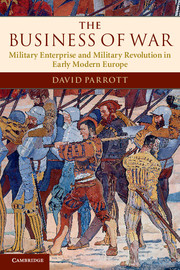Refine search
Actions for selected content:
15418 results in Military history
Chapter 3 - A huge and horrible slaughter house
-
- Book:
- Pozières
- Published online:
- 05 January 2015
- Print publication:
- 15 January 2015, pp 47-74
-
- Chapter
- Export citation
Maps
-
- Book:
- Pozières
- Published online:
- 05 January 2015
- Print publication:
- 15 January 2015, pp ix-x
-
- Chapter
- Export citation
Acknowledgements
-
- Book:
- Pozières
- Published online:
- 05 January 2015
- Print publication:
- 15 January 2015, pp xi-xii
-
- Chapter
- Export citation
Contents
-
- Book:
- Pozières
- Published online:
- 05 January 2015
- Print publication:
- 15 January 2015, pp v-vi
-
- Chapter
- Export citation
Introduction
-
- Book:
- Pozières
- Published online:
- 05 January 2015
- Print publication:
- 15 January 2015, pp 1-6
-
- Chapter
- Export citation

Pozières
- Echoes of a Distant Battle
-
- Published online:
- 05 January 2015
- Print publication:
- 15 January 2015

The Business of War
- Military Enterprise and Military Revolution in Early Modern Europe
-
- Published online:
- 05 January 2015
- Print publication:
- 08 March 2012
5 - ‘The Soldiers Murmured Much on Account of this Usage’: Military Justice and Negotiated Authority in the Eighteenth-Century British Army
- from Part 3 - Discipline
-
-
- Book:
- Britain's Soldiers
- Published by:
- Liverpool University Press
- Published online:
- 04 July 2017
- Print publication:
- 31 December 2014, pp 95-113
-
- Chapter
- Export citation
Frontmatter
-
- Book:
- Britain's Soldiers
- Published by:
- Liverpool University Press
- Published online:
- 04 July 2017
- Print publication:
- 31 December 2014, pp i-iv
-
- Chapter
- Export citation
7 - Conflicts of Conduct: British Masculinity and Military Painting in the Wake of the Siege of Gibraltar
- from Part 4 - Gender
-
-
- Book:
- Britain's Soldiers
- Published by:
- Liverpool University Press
- Published online:
- 04 July 2017
- Print publication:
- 31 December 2014, pp 133-154
-
- Chapter
- Export citation
10 - Making New Soldiers: Legitimacy, Identity and Attitudes, c. 1740–1815
- from Part 5 - Soldiers in Society
-
-
- Book:
- Britain's Soldiers
- Published by:
- Liverpool University Press
- Published online:
- 04 July 2017
- Print publication:
- 31 December 2014, pp 202-219
-
- Chapter
- Export citation
9 - Disability, Fraud and Medical Experience at the Royal Hospital of Chelsea in the Long Eighteenth Century
- from Part 5 - Soldiers in Society
-
-
- Book:
- Britain's Soldiers
- Published by:
- Liverpool University Press
- Published online:
- 04 July 2017
- Print publication:
- 31 December 2014, pp 183-201
-
- Chapter
- Export citation
Part 1 - Nationhood
-
- Book:
- Britain's Soldiers
- Published by:
- Liverpool University Press
- Published online:
- 04 July 2017
- Print publication:
- 31 December 2014, pp 15-16
-
- Chapter
- Export citation
4 - Stamford Standoff: Honour, Status and Rivalry in the Georgian Military
- from Part 2 - Hierarchy
-
-
- Book:
- Britain's Soldiers
- Published by:
- Liverpool University Press
- Published online:
- 04 July 2017
- Print publication:
- 31 December 2014, pp 77-92
-
- Chapter
- Export citation
Part 5 - Soldiers in Society
-
- Book:
- Britain's Soldiers
- Published by:
- Liverpool University Press
- Published online:
- 04 July 2017
- Print publication:
- 31 December 2014, pp 181-182
-
- Chapter
- Export citation
Index
-
- Book:
- Britain's Soldiers
- Published by:
- Liverpool University Press
- Published online:
- 04 July 2017
- Print publication:
- 31 December 2014, pp 220-225
-
- Chapter
- Export citation
Part 2 - Hierarchy
-
- Book:
- Britain's Soldiers
- Published by:
- Liverpool University Press
- Published online:
- 04 July 2017
- Print publication:
- 31 December 2014, pp 55-56
-
- Chapter
- Export citation
1 - The Eighteenth-Century British Army as a European Institution
- from Part 1 - Nationhood
-
-
- Book:
- Britain's Soldiers
- Published by:
- Liverpool University Press
- Published online:
- 04 July 2017
- Print publication:
- 31 December 2014, pp 17-38
-
- Chapter
- Export citation
Part 3 - Discipline
-
- Book:
- Britain's Soldiers
- Published by:
- Liverpool University Press
- Published online:
- 04 July 2017
- Print publication:
- 31 December 2014, pp 93-94
-
- Chapter
- Export citation
6 - Discipline and Control in Eighteenth-Century Gibraltar
- from Part 3 - Discipline
-
-
- Book:
- Britain's Soldiers
- Published by:
- Liverpool University Press
- Published online:
- 04 July 2017
- Print publication:
- 31 December 2014, pp 114-130
-
- Chapter
- Export citation
